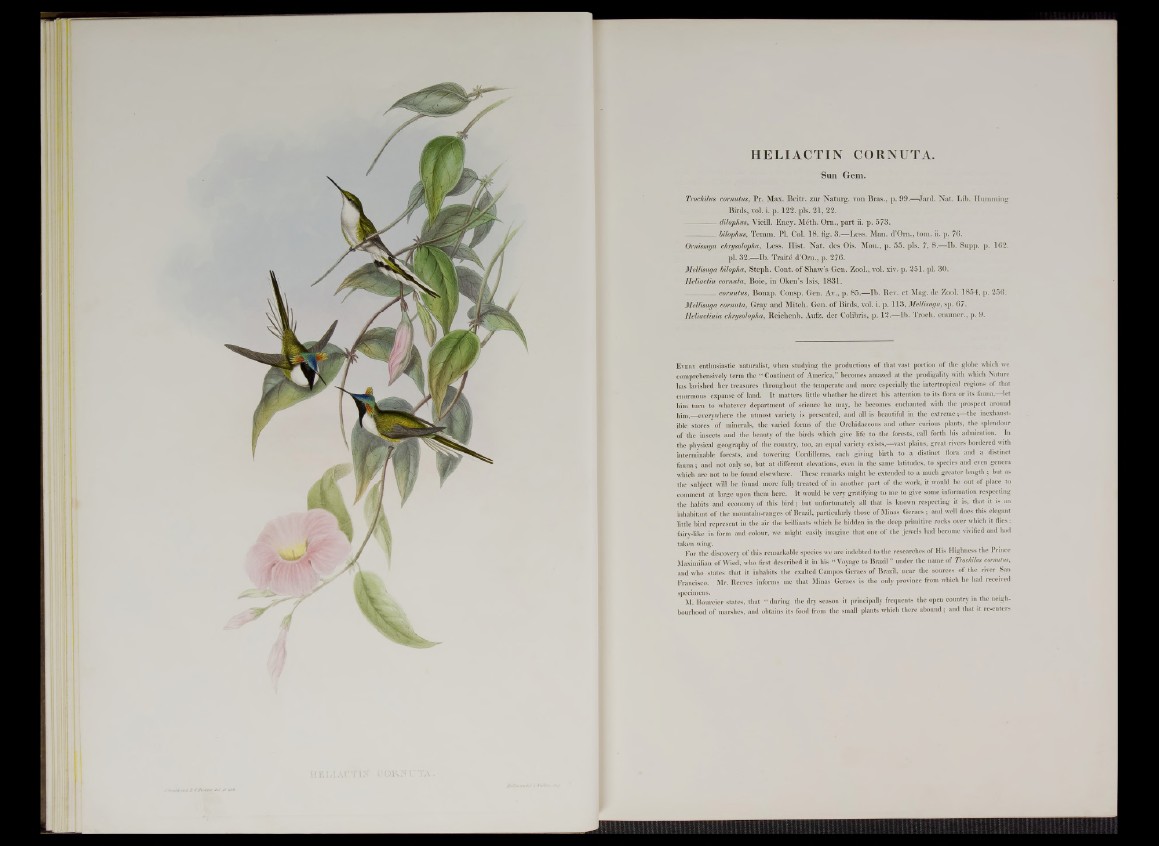
HELIACTIN CORNUTA.
Sun Gem.
Trochilm cornutus, Pr. Max. Beitr. zur Naturg. von Bras., p. 99.—Jard. Nat. Lib. Humming
Birds, vol. i. p. 122. pis. 21, 22.
-------------dilophus, Vieill. Ency. Méth. Om., p a rt ii. p. 573.
-------------bïlophus, Temm. Pl. Col. 18. fig. 3.—Less. Man. d’Om., tom. ii. p. 76.
Ornismya chrysolopha, Less. Hist. N a t. des Ois. Mou., p. 55. pis. 7, 8.—Ib . Supp. p. 162.
pl. 32§^j-Ib. Traité d ’Om., p. 276.
Mellimya bilopha, Steph. Cont. o f Shaw’s Gen. Zool., vol. xiv. p. 251. pl. 30.
Heliactin cornuta, Boie, in Olcen’s Isis, 1831.
cornutus, Bonap. Consp. Gen. Av., p. 85.—Ib. Rev. e t Mag. de Zool. 1854, p. 256.
Mellimya cornuta, Gray and Mitch. Gen. o f Birds, vol. i. p. 113, Mellimya, sp. 67.
Heliactinia chrysolopha, Reichenb. Aufz. der Colibris, p. 12.—Ib. Troçh. enumer., p. 9.
Every enthusiastic naturalist, when studying the productions of that vast portion of the globe which we
comprehensively term the “ Continent of America,” becomes amazed at the prodigality with which Nature
has lavished her treasures throughout the temperate and more especially the intertropical regions of that
enormous expanse of land. It matters little whether he direct his attention to its flora or its fauna,—let
him turn to whatever department of science he may, he becomes enchanted with the prospect around
him,—everywhere the utmost variety is presented, and all is beautiful in the extreme ;—the inexhaustible
stores of minerals, the varied forms of the Orchidaceous and other curious plants, the splendour
of the insects and the beauty of the birds which give life to the forests, call forth his admiration. In
the physical geography of the country, too, an equal variety exists,—vast plains, great rivers bordered with
interminable forests, and towering Cordilleras, each giving birth to a distinct flora and a distinct
fauna ; and not only so, but at different elevations, even in the same latitudes, to species and even genera
which are not to be found elsewhere. These remarks might be extended to a much greater length ; but as
the subject will be found more fully treated of in another part of the work, it would be out of place to
comment at large upon them here. It would be very gratifying to me to give some information respecting
the habits and economy of this bird ; but unfortunately all that is known respecting it is, that it is an
inhabitant of the mountain-ranges of Brazil, particularly those of Minas Geraes ; and well does this elegant
little bird represent in the air the brilliants which lie hidden in the deep primitive rocks over which it flies :
fairy-like in form and colour, we might easily imagine that one of thè jewels had become vivified and had
taken wing.
For the discovery of this remarkable species we are indebted to the researches of His Highness the Prince
Maximilian of Wied, who first described it in his “ Voyage to Brazil” under the name of Trochilus cornutus,
and who states that it inhabits the exalted Campos Geraes of Brazil, near the sources of the river San
Francisco. Mr. Reeves informs me that Minas Geraes is the only province from which he had received
specimens.
M. Bourcier states, that “ during the dry season it principally frequents the open country in the neighbourhood
of marshes, and obtains its food from the small plants which there abound ; and that it re-enters